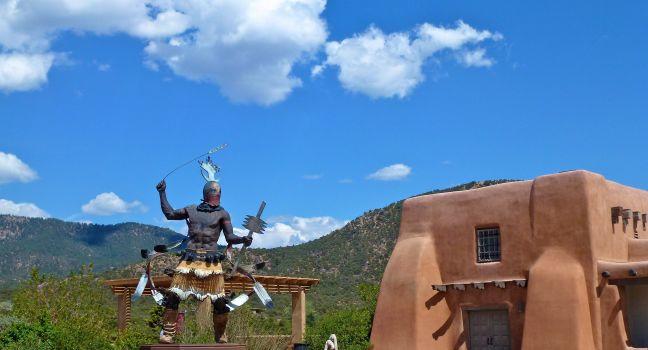Atop a 367-foot mesa that rises abruptly from the valley floor, Acoma Pueblo's terraced, multistory, multiunit Sky City is like no other pueblo structure. It's one of the oldest continually inhabited spots in North America, with portions believed to be more than 1,500 years old. Captain Hernando de Alvarado, a member of Francisco Vásquez de Coronado's expedition of 1540, was the first European to see Acoma. He reported that he had "found a rock with a village on top, the strongest position ever seen in the world." The Spanish eventually conquered the Acoma people and brutally compelled them to build San Estéban del Rey, the immense adobe church that stands to this day. Native American laborers cut the massive vigas for the church's ceiling 30 mi away on Mt. Taylor and physically carried them back to the mesa.
About a dozen families live at the mesa-top pueblo full time, with most other Acomas living on Native American land nearby and returning only in summer and for celebrations, such as the feast day of St. Stephen (September 2), and Christmas mass (both are open to the public). Acoma's artisans are known for their thin-walled pottery, hand-painted with intricate black-and-white or polychrome geometrical patterns.
Once you park at the mesa base, plan to spend time in the superb Haak'u Museum at the Sky City Cultural Center. Changing exhibits explore traditional and contemporary arts, and are perfectly set in this modernist interpretation of traditional pueblo forms, with fine sandstone detailing and glass panels prepared to evoke historic mica windows. Visitation on the mesa top is by an hour-long guided tour; you're whisked by van up a steep road from behind the center and then led about the mesa community on foot (allow extra time if you choose to walk back down instead, via the ancient staircase carved into the side of the mesa). An Acoma guide will point out kivas, hornos, and unforgettable views toward their sacred sites of Enchanted Mesa and Mt. Taylor, and describe pueblo history in-depth, as well as direct you to artisan displays throughout the village. (Note: the terrain can be uneven; heeled shoes or flip-flops are not advised.) There's no electricity or running water in the village, but you can see cars parked outside many homes—one wonders what it must have been like to visit Acoma before the road was constructed in 1969. Open hours vary slightly, depending on the weather. Videotaping, sketching, and painting are prohibited, and a permit is required for still photography. Note that the pueblo prohibits photography of the church interior and exterior as well as the adjoining cemetery. As at all indigenous locales, ask permission before photographing residents or their artwork. Regroup back at Haak'u and browse the gallery gift shop and bookstore or enjoy blue-corn pancakes or a grilled chicken wrap with green-chile guacamole at the cozy Y'aak'a (Corn) Café. There is shuttle service available if you are staying at the Sky City Hotel/Casino (888/759–2489). Open hours are subject to tribal activities or weather conditions; it is best to check their online calendar or call ahead.




